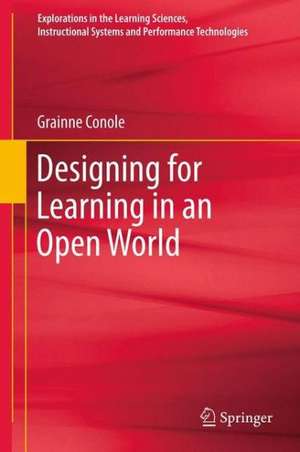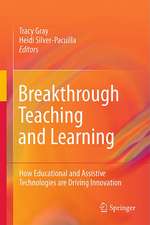Designing for Learning in an Open World: Explorations in the Learning Sciences, Instructional Systems and Performance Technologies, cartea 4
Autor Gráinne Conoleen Limba Engleză Paperback – 15 oct 2014
| Toate formatele și edițiile | Preț | Express |
|---|---|---|
| Paperback (1) | 637.78 lei 43-57 zile | |
| Springer – 15 oct 2014 | 637.78 lei 43-57 zile | |
| Hardback (1) | 641.85 lei 43-57 zile | |
| Springer – 21 sep 2012 | 641.85 lei 43-57 zile |
Preț: 637.78 lei
Preț vechi: 750.33 lei
-15% Nou
Puncte Express: 957
Preț estimativ în valută:
122.15€ • 125.85$ • 102.32£
122.15€ • 125.85$ • 102.32£
Carte tipărită la comandă
Livrare economică 24 februarie-10 martie
Preluare comenzi: 021 569.72.76
Specificații
ISBN-13: 9781493902026
ISBN-10: 1493902024
Pagini: 340
Ilustrații: XVI, 324 p.
Dimensiuni: 155 x 235 x 18 mm
Greutate: 0.48 kg
Ediția:2013
Editura: Springer
Colecția Springer
Seria Explorations in the Learning Sciences, Instructional Systems and Performance Technologies
Locul publicării:New York, NY, United States
ISBN-10: 1493902024
Pagini: 340
Ilustrații: XVI, 324 p.
Dimensiuni: 155 x 235 x 18 mm
Greutate: 0.48 kg
Ediția:2013
Editura: Springer
Colecția Springer
Seria Explorations in the Learning Sciences, Instructional Systems and Performance Technologies
Locul publicării:New York, NY, United States
Public țintă
ResearchCuprins
Table of Contents
1. Preface: origins of and rationale for the book.-
2. Setting the scene
3. Overview
b. 4. The context of modern education
c. 5. The nature of educational technology
d. 6. Today’s learners
e. 7. The need for a new learning design methodology
f. 8. Audience and structure of the book
g. 9. The process of writing the book.-
Ch 2 Design languages
a. Introduction
b. The challenges of designing for learning
c. Design languages
d. Design notation in music, architecture and chemistry
i. Musical notation
ii. Architectural notation
iii. Chemical notation
e. Learning design
i. Defining learning design
ii. The origins of learning design
iii. A spectrum of learning design languages
f. Origins of the Open Learning Design methodology
i. The OU Learning Design Initiative
ii. Design-Based Research
iii. The OULDI learning design methodology
g. Conclusion.-
Ch 3: Related research fields
a. Introduction
b. Instructional Design
c. Learning Sciences
d. Learning objects and Open Educational Practices
e. Pedagogical Patterns
f. Professional networks and support centres
g. Conclusion.-
Ch 4: Open, social and participatory media
a. Introduction
b. The changing digital landscape of education
c. A review of new technologies
i. The characteristics of new technologies
ii. The impact of Web 2.0 technologies
iii. The use of Web 2.0 technologies in education
iv. The impact on practice
d. A review of Web 2.0 tools and practice
e. Conclusion.-
Theoretical perspectives
Ch 5 Theory and methodology in learning design research
a. Introduction
b. Definitions
c. Researchers’ home disciplines
d. The nature of theory
e. Theoretical perspectives
i. Cultural Historical Activity Theory (CHAT)
ii. Communities of Practice
iii. Actor Network Theory
iv. Cybernetics and systems thinking
a. Methodological approaches
i. Content analysis
ii. Ethnography
iii. Case studies
iv. Action research
v. Evaluation
vi. Choosing an appropriate methodology
b. Influences, beliefs and theoretical perspectives
c. Conclusion.-
Ch 6 The role of Mediating Artifacts in learning design
a. Introduction
b. The origins of the concept of Mediating Artifacts
c. Capturing and representing practice
d. Examples of Mediating Artifacts
e. Understanding learning activities through Mediating Artifacts
f. Meta-Mediating Artifacts
g. An illustrative example of the application of this approach
i. Teacher A: The design phase
ii. Learner A: Use Scenario 1 - beginner’s route
iii. Learner B: Use Scenario 2 - advanced route
iv. Teacher B: Use Scenario 3 - repurposing
h. Conclusion.-
Ch 7 Affordances
a. Introduction
b. Definitions of the term
c. ICT affordances
i. Collaboration
ii. Reflection
iii. Interaction
iv. Dialogue
v. Creativity
vi. Organization
vii. Inquiry
viii. Authenticity
ix. Negative affordances - constraints
a. Conclusion.-
Design representations and tools
Ch 8 Design representations
a. Introduction
b. Types of representation
c. Examples of different types of representations
i. Textual
ii. Content map
iii. The course mapview
iv. The pedagogy profile
v. The task swimlane representation
vi. Learning outcomes map
vii. The course dimensions view
viii. Principles/pedagogy matrix
d. Evaluation of the views
e. An example of application of the representations
i. Course view
ii. Pedagogical profile
iii. Course dimensions
iv. Learning outcomes
v. Task swimlane
f. Conclusion.-
Ch 9 Case study: tools for visualizing designs
a. Introduction
b. Practitioners’ approaches to design
c. Repurposing an Open Educational Resource
d. The development of Compendium LD
e. Evaluation of the use of Compendium LD
f. Use by practitioners
g. Use by studentsh. Other visualization tools
i. Conclusion.-
Ch 10 Pedagogical planners
a. Introduction
b. The need for pedagogical planners
c. Examples of pedagogical planners
i. The DialogPlus toolkit
ii. Phoebe
iii. The London Pedagogical Planner (LPP)
iv. The Learning Design Support Environment (LDSE)
d. Conclusion.-
Openness
Ch 11 The nature of openness
a. Introduction
b. Facets of openness
i. Open design
ii. Open delivery
iii. Open evaluation
iv. Open research
c. Principles
d. Defining openness
e. Characteristics of openness
f. The OU’s Supported Open Learning (SOL) model
g. Applying openness
i. Open design
ii. Open delivery
iii. Open evaluation
iv. Open research
h. Conclusion.-
Ch 12 Open Educational Resources
a. Introduction
b. The Open Educational Resource movement
c. A review of OER initiatives
d. Case study 1: Openlearn
e. Case study 2: Wikiwijs
f. Case study 3: LeMill
g. Case study 4: Podcampus
h. Conclusion
i. Appendix: The broader OER landscape.-
Ch 13 Case study: Realising the vision of Open Educational Resources
a. Introduction
b. The Olnet initiative
c. The OPAL initiative
i. Strategies and policies
ii. Quality assurance models
iii. Collaborative and partnership modles
iv. Tools and tool practices
v. Innovations
vi. Skills development and support
vii. Business models and sustainability strategies
viii. Barriers and enablers
d. Enhancing the quality and innovation of OER
e. Conclusion.-
Social and participatory media
Ch 14: Online communities and interactions
a. Introduction
b. The co-evolution of tools and practice
c. Modes of interaction
d. The changing nature of online communities
e. The pedagogies of e-learning
f. Sfard’s metaphors of learning
g. Frameworks for supporting online communities
h. The Community Indicators Framework
i. Conclusion.-
Ch 15 Case study: Cloudworks
a. Introduction
b. Cloudworks
c. Theoretical underpinnings
d. Evaluation of the OU Learning and Teaching Cloudscape
e. Using Cloudworks to support learning.-
Conclusion
Ch 16 Conclusion, implications and reflections
Postscript - reflections on adopting an open approach to the writing of the book.
1. Preface: origins of and rationale for the book.-
2. Setting the scene
3. Overview
b. 4. The context of modern education
c. 5. The nature of educational technology
d. 6. Today’s learners
e. 7. The need for a new learning design methodology
f. 8. Audience and structure of the book
g. 9. The process of writing the book.-
Ch 2 Design languages
a. Introduction
b. The challenges of designing for learning
c. Design languages
d. Design notation in music, architecture and chemistry
i. Musical notation
ii. Architectural notation
iii. Chemical notation
e. Learning design
i. Defining learning design
ii. The origins of learning design
iii. A spectrum of learning design languages
f. Origins of the Open Learning Design methodology
i. The OU Learning Design Initiative
ii. Design-Based Research
iii. The OULDI learning design methodology
g. Conclusion.-
Ch 3: Related research fields
a. Introduction
b. Instructional Design
c. Learning Sciences
d. Learning objects and Open Educational Practices
e. Pedagogical Patterns
f. Professional networks and support centres
g. Conclusion.-
Ch 4: Open, social and participatory media
a. Introduction
b. The changing digital landscape of education
c. A review of new technologies
i. The characteristics of new technologies
ii. The impact of Web 2.0 technologies
iii. The use of Web 2.0 technologies in education
iv. The impact on practice
d. A review of Web 2.0 tools and practice
e. Conclusion.-
Theoretical perspectives
Ch 5 Theory and methodology in learning design research
a. Introduction
b. Definitions
c. Researchers’ home disciplines
d. The nature of theory
e. Theoretical perspectives
i. Cultural Historical Activity Theory (CHAT)
ii. Communities of Practice
iii. Actor Network Theory
iv. Cybernetics and systems thinking
a. Methodological approaches
i. Content analysis
ii. Ethnography
iii. Case studies
iv. Action research
v. Evaluation
vi. Choosing an appropriate methodology
b. Influences, beliefs and theoretical perspectives
c. Conclusion.-
Ch 6 The role of Mediating Artifacts in learning design
a. Introduction
b. The origins of the concept of Mediating Artifacts
c. Capturing and representing practice
d. Examples of Mediating Artifacts
e. Understanding learning activities through Mediating Artifacts
f. Meta-Mediating Artifacts
g. An illustrative example of the application of this approach
i. Teacher A: The design phase
ii. Learner A: Use Scenario 1 - beginner’s route
iii. Learner B: Use Scenario 2 - advanced route
iv. Teacher B: Use Scenario 3 - repurposing
h. Conclusion.-
Ch 7 Affordances
a. Introduction
b. Definitions of the term
c. ICT affordances
i. Collaboration
ii. Reflection
iii. Interaction
iv. Dialogue
v. Creativity
vi. Organization
vii. Inquiry
viii. Authenticity
ix. Negative affordances - constraints
a. Conclusion.-
Design representations and tools
Ch 8 Design representations
a. Introduction
b. Types of representation
c. Examples of different types of representations
i. Textual
ii. Content map
iii. The course mapview
iv. The pedagogy profile
v. The task swimlane representation
vi. Learning outcomes map
vii. The course dimensions view
viii. Principles/pedagogy matrix
d. Evaluation of the views
e. An example of application of the representations
i. Course view
ii. Pedagogical profile
iii. Course dimensions
iv. Learning outcomes
v. Task swimlane
f. Conclusion.-
Ch 9 Case study: tools for visualizing designs
a. Introduction
b. Practitioners’ approaches to design
c. Repurposing an Open Educational Resource
d. The development of Compendium LD
e. Evaluation of the use of Compendium LD
f. Use by practitioners
g. Use by studentsh. Other visualization tools
i. Conclusion.-
Ch 10 Pedagogical planners
a. Introduction
b. The need for pedagogical planners
c. Examples of pedagogical planners
i. The DialogPlus toolkit
ii. Phoebe
iii. The London Pedagogical Planner (LPP)
iv. The Learning Design Support Environment (LDSE)
d. Conclusion.-
Openness
Ch 11 The nature of openness
a. Introduction
b. Facets of openness
i. Open design
ii. Open delivery
iii. Open evaluation
iv. Open research
c. Principles
d. Defining openness
e. Characteristics of openness
f. The OU’s Supported Open Learning (SOL) model
g. Applying openness
i. Open design
ii. Open delivery
iii. Open evaluation
iv. Open research
h. Conclusion.-
Ch 12 Open Educational Resources
a. Introduction
b. The Open Educational Resource movement
c. A review of OER initiatives
d. Case study 1: Openlearn
e. Case study 2: Wikiwijs
f. Case study 3: LeMill
g. Case study 4: Podcampus
h. Conclusion
i. Appendix: The broader OER landscape.-
Ch 13 Case study: Realising the vision of Open Educational Resources
a. Introduction
b. The Olnet initiative
c. The OPAL initiative
i. Strategies and policies
ii. Quality assurance models
iii. Collaborative and partnership modles
iv. Tools and tool practices
v. Innovations
vi. Skills development and support
vii. Business models and sustainability strategies
viii. Barriers and enablers
d. Enhancing the quality and innovation of OER
e. Conclusion.-
Social and participatory media
Ch 14: Online communities and interactions
a. Introduction
b. The co-evolution of tools and practice
c. Modes of interaction
d. The changing nature of online communities
e. The pedagogies of e-learning
f. Sfard’s metaphors of learning
g. Frameworks for supporting online communities
h. The Community Indicators Framework
i. Conclusion.-
Ch 15 Case study: Cloudworks
a. Introduction
b. Cloudworks
c. Theoretical underpinnings
d. Evaluation of the OU Learning and Teaching Cloudscape
e. Using Cloudworks to support learning.-
Conclusion
Ch 16 Conclusion, implications and reflections
Postscript - reflections on adopting an open approach to the writing of the book.
Textul de pe ultima copertă
Designing for Learning in an Open World provides specific information and research for acquiring the requisite skills to both design and support learning opportunities that harness the potential of available technologies.
Further, Designing for Learning in an Open World proposes new, innovative learning pathways, created to empower learners to blend formal educational offerings with free resources and services. The new approach and new pathways suggested by the author force readers to rethink the entire instructional design process, enabling both teachers and learners to take into account a blended learning context, now the norm in our modern educational environment.
Further, Designing for Learning in an Open World proposes new, innovative learning pathways, created to empower learners to blend formal educational offerings with free resources and services. The new approach and new pathways suggested by the author force readers to rethink the entire instructional design process, enabling both teachers and learners to take into account a blended learning context, now the norm in our modern educational environment.
Caracteristici
Details a range of innovative tools and design methods Provides a theoretical underpinning and contextualization with related research in the field Provides practical examples and case studies using innovative tools and methodologies Clarifies the relationship between learning design and related fields








